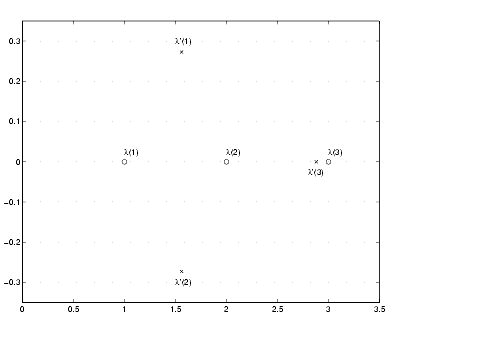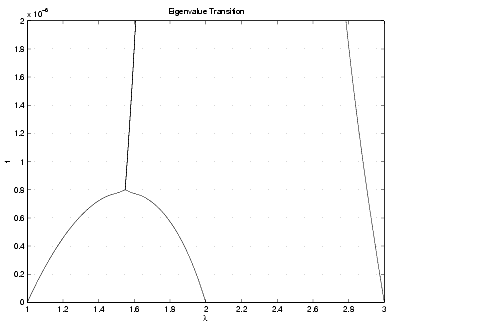

| Symbolic Math Toolbox |   |
Eigenvalue Trajectories
This example applies several numeric, symbolic, and graphic techniques to study the behavior of matrix eigenvalues as a parameter in the matrix is varied. This particular setting involves numerical analysis and perturbation theory, but the techniques illustrated are more widely applicable.
 . As t increases from 0 to 10-6, the eigenvalues
. As t increases from 0 to 10-6, the eigenvalues  ,
,  ,
,  change to
change to  ,
,  ,
,  .
.

This, in turn, means that for some value of  , the perturbed matrix A(t) = A + tE has a double eigenvalue
, the perturbed matrix A(t) = A + tE has a double eigenvalue  .
.
t, called  , where this happens.
The starting point is a MATLAB test example, known as
, where this happens.
The starting point is a MATLAB test example, known as gallery(3).
A = gallery(3) A = -149 -50 -154 537 180 546 -27 -9 -25This is an example of a matrix whose eigenvalues are sensitive to the effects of roundoff errors introduced during their computation. The actual computed eigenvalues may vary from one machine to another, but on a typical workstation, the statements
format long e = eig(A)produce
e = 0.99999999999642 2.00000000000579 2.99999999999780Of course, the example was created so that its eigenvalues are actually 1, 2, and 3. Note that three or four digits have been lost to roundoff. This can be easily verified with the toolbox. The statements
B = sym(A); e = eig(B)' p = poly(B) f = factor(p)produce
e = [1, 2, 3] p = x^3-6*x^2+11*x-6 f = (x-1)*(x-2)*(x-3)Are the eigenvalues sensitive to the perturbations caused by roundoff error because they are "close together"? Ordinarily, the values 1, 2, and 3 would be regarded as "well separated." But, in this case, the separation should be viewed on the scale of the original matrix. If
A were replaced by A/1000, the eigenvalues, which would be .001, .002, .003, would "seem" to be closer together.
But eigenvalue sensitivity is more subtle than just "closeness." With a carefully chosen perturbation of the matrix, it is possible to make two of its eigenvalues coalesce into an actual double root that is extremely sensitive to roundoff and other errors.
One good perturbation direction can be obtained from the outer product of the left and right eigenvectors associated with the most sensitive eigenvalue. The following statement creates
E = [130,-390,0;43,-129,0;133,-399,0]the perturbation matrix
E = 130 -390 0 43 -129 0 133 -399 0The perturbation can now be expressed in terms of a single, scalar parameter
t. The statements
syms x t A = A+t*Ereplace
A with the symbolic representation of its perturbation.
A = [-149+130*t, -50-390*t, -154] [ 537+43*t, 180-129*t, 546] [ -27+133*t, -9-399*t, -25]Computing the characteristic polynomial of this new
A
p = poly(A)gives
p = x^3-6*x^2+11*x-t*x^2+492512*t*x-6-1221271*tPrettyprinting
pretty(collect(p,x))shows more clearly that
p is a cubic in x whose coefficients vary linearly with t.
3 2 x + (- t - 6) x + (492512 t + 11) x - 6 - 1221271 tIt turns out that when
t is varied over a very small interval, from 0 to 1.0e-6, the desired double root appears. This can best be seen graphically. The first figure shows plots of p, considered as a function of x, for three different values of t: t = 0, t = 0.5e-6, and t = 1.0e-6. For each value, the eigenvalues are computed numerically and also plotted.
x = .8:.01:3.2; for k = 0:2 c = sym2poly(subs(p,t,k*0.5e-6)); y = polyval(c,x); lambda = eig(double(subs(A,t,k*0.5e-6))); subplot(3,1,3-k) plot(x,y,'-',x,0*x,':',lambda,0*lambda,'o') axis([.8 3.2 -.5 .5]) text(2.25,.35,['t = ' num2str( k*0.5e-6 )]); endThe bottom subplot shows the unperturbed polynomial, with its three roots at 1, 2, and 3. The middle subplot shows the first two roots approaching each other. In the top subplot, these two roots have become complex and only one real root remains. The next statements compute and display the actual eigenvalues
showing thate = eig(A);pretty(e)
e(2) and e(3) form a complex conjugate pair.
[ 1/3 ]
[ 1/3 %1 - 3 %2 + 2 + 1/3 t ]
[ ]
[ 1/3 1/2 1/3 ]
[- 1/6 %1 + 3/2 %2 + 2 + 1/3 t + 1/2 i 3 (1/3 %1 + 3 %2)]
[ ]
[ 1/3 1/2 1/3 ]
[- 1/6 %1 + 3/2 %2 + 2 + 1/3 t - 1/2 i 3 (1/3 %1 + 3 %2)]
2 3
%1 := 3189393 t - 2216286 t + t + 3 (-3 + 4432572 t
2 3
- 1052829647418 t + 358392752910068940 t
4 1/2
- 181922388795 t )
2
- 1/3 + 492508/3 t - 1/9 t
%2 := ---------------------------
1/3
%1
Next, the symbolic representations of the three eigenvalues are evaluated at many values of t
tvals = (2:-.02:0)' * 1.e-6;
r = size(tvals,1);
c = size(e,1);
lambda = zeros(r,c);
for k = 1:c
lambda(:,k) = double(subs(e(k),t,tvals));
end
plot(lambda,tvals)
xlabel('\lambda'); ylabel('t');
title('Eigenvalue Transition')
to produce a plot of their trajectories.

Above t = 0.8e-6, the graphs of two of the eigenvalues intersect, while below t = 0.8e-6, two real roots become a complex conjugate pair. What is the precise value of t that marks this transition? Let  denote this value of
denote this value of t.
 involves polynomial discriminants. The discriminant of a quadratic polynomial is the familiar quantity under the square root sign in the quadratic formula. When it is negative, the two roots are complex.
There is no
involves polynomial discriminants. The discriminant of a quadratic polynomial is the familiar quantity under the square root sign in the quadratic formula. When it is negative, the two roots are complex.
There is no discrim function in the toolbox, but there is one in Maple and it can be accessed through the toolbox's maple function. The statement
mhelp discrimprovides a brief explanation. Use these commands
syms a b c x
maple('discrim', a*x^2+b*x+c, x)
to show the generic quadratic's discriminant, b2 - 4ac
ans = -4*a*c+b^2The discriminant for the perturbed cubic characteristic polynomial is obtained, using
discrim = maple('discrim',p,x)
which produces
[discrim = 4-5910096*t+1403772863224*t^2-477857003880091920*t^3+2425631850 60*t^4]The quantity
 is one of the four roots of this quartic. Let's find a numeric value for
is one of the four roots of this quartic. Let's find a numeric value for  .
.
digits(24) s = solve(discrim); tau = vpa(s) tau = [ 1970031.04061804553618913] [ .783792490602e-6] [ .1076924816049e-5+.318896441018863170083895e-5*i] [ .1076924816049e-5-.318896441018863170083895e-5*i]Of the four solutions, we know that
tau = tau(2)is the transition point
tau = .783792490602e-6because it is closest to our previous estimate. A more generally applicable method for finding
 is based on the fact that, at a double root, both the function and its derivative must vanish. This results in two polynomial equations to be solved for two unknowns. The statement
is based on the fact that, at a double root, both the function and its derivative must vanish. This results in two polynomial equations to be solved for two unknowns. The statement
sol = solve(p,diff(p,'x'))solves the pair of algebraic equations
p = 0 and dp/dx = 0 and produces
sol =
t: [4x1 sym]
x: [4x1 sym]
Find  now by
now by
tau = double(sol.t(2))which reveals that the second element of
sol.t is the desired value of  .
.
format short tau = 7.8379e-07Therefore, the second element of
sol.x
sigma = double(sol.x(2))is the double eigenvalue
sigma = 1.5476Let's verify that this value of
 does indeed produce a double eigenvalue at
does indeed produce a double eigenvalue at  . To achieve this, substitute
. To achieve this, substitute  for t in the perturbed matrix
for t in the perturbed matrix e = eig(double(subs(A,t,tau))) e = 1.5476 1.5476 2.9047confirms that
 is a double eigenvalue of A(t) for t = 7.8379e-07.
is a double eigenvalue of A(t) for t = 7.8379e-07.
 | Singular Value Decomposition | Solving Equations |  |